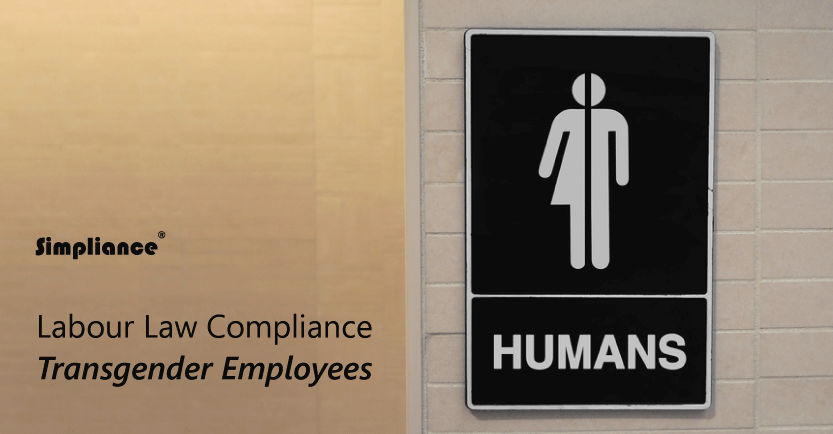
Animay Singh
Biography

Introduction
In our previous article titled Transgender Persons and Labour Law: A Grey Area, we had discussed the need for concrete steps to address some of the lacunae pertaining to transgender employees in the workplace. Today’s blog shall examine the combined impact of the Transgender Persons (Protection of Rights) Act, 2019 read with its corresponding Transgender Persons (Protection of Rights) Rules, 2020. We shall analyze their combined effect on labour law compliance and examine suitable steps to implement policies that satisfy the legal obligation on employers.
Labour Law Compliance Decoded
The combined impact of the Act and rule on labour law compliance can be summarized as follows:-
| Statutory Provision | Description | Compliance Requirement |
| Section-9 of the Act read with Rule-12 | Non-Discrimination and Equal Opportunities in Employment | No establishment shall discriminate against any transgender person in any matter relating to employment. Every establishment shall implement and publish an equal opportunity policy for transgender persons. The establishment shall display the equal opportunity policy including details relating to the complaints officer on their website or at a conspicuous place on their premises. The equal opportunity policy shall contain details relating to-
|
| Section-11 of the Act read with Rule-13 | Grievance Redressal Mechanism | Every establishment must designate a complaint officer who shall enquire into the complaints received within 15 days of receipt of the same. The head of the establishment shall act on the enquiry report submitted by the complaints officer within 15 days from the date of submission of the report. |
How to create an Equal Opportunity Policy
The above section makes the employer-side compliance requirements clear in terms of the law; however, several establishments are not aware of the manner in which an equal opportunity policy should be created. It is important to understand that the basic objective of such a policy is to facilitate the creation of an inclusive workplace culture. To this end, the policy must first recognize the statutory rights of transgender employees and then provide a set of guidelines for protecting the same.
The statute lists unisex toilets, security measures, amenities to be provided, confidentiality of gender identity, procedure to make complaints and applicability of company rules as essential aspects of such a policy. We examined the contents of equal opportunity clauses across different countries and organizations to create this list of essential clauses suitable for the Indian workplace:
1. Definition Clause
Like any other policy such as that under the Sexual Harassment of Women at Workplace (Prevention, Prohibition and Redressal) Act, 2013, a definition clause aims to explain key terms so as to eliminate any doubt pertaining to their construction and interpretation. Thus, one beneficial step an employer may adopt is defining the term transgender person in their policy in consonance with the definition of the term under Act. Employers can go one step further and define terms such as trans-man, trans-woman, non-binary/genderqueer, intersex etc. to help employees understand the differences between them.
2. Privacy Clause
As this is a statutorily mandated clause, employers must ensure it is a part of the policy as a priority. This is because information about a transgender employee’s sex at birth is confidential medical information. Therefore, disclosure of the same can lead to violation of their right to privacy and create legal hassles. Such information may only be shared with the transgender employee’s written consent on a need-to-know basis.
3. Guidelines on Usage of Unisex Toilets
A unisex or gender-neutral toilet is one that is not segregated on the basis of sex. This ensures that transgender employees are afforded the requisite freedom as well as privacy when it comes to making use of the establishment’s facilities. Additionally, transgender women must be permitted to use the women’s restroom and transgender men must be permitted to use the male restroom, if they desire to do so.
4. Gender Neutral Dress Codes
Several companies have separate dress code requirements for men and women, this may prove to be a hindrance for transitioning transgender employees who may have to choose between clothes for men and women or vice-versa. Therefore, a policy that mandates company dress code irrespective of gender shall ensure that the transgender employees are not placed in uncomfortable situations and that employees can comply with the dress code in a manner consistent with their gender identity.
5. Anti-Discrimination/Harassment clause
The policy must clearly state that discrimination in any employment related situation such as recruitment, promotion or use of facilities and harassment of any kind whether verbal, mental or sexual shall be strictly penalized. An internal committee must be set up for the investigation of such incidents and must be composed so as to adequately represent transgender employees. The grievance redressal committee must be set up and a complaints officer must be designated as mandated by the Act. Penalties for violation of the policy must also be provided with strict enforcement to ensure compliance.
6. Miscellaneous
Other clauses that may be incorporated include those pertaining to health insurance, employee resource groups, sensitization training and programs as well as periodic review of the policy. It is also important to ensure that investigation of incidents and complaints is carried out in consonance with the principles of natural justice. No procedure adopted should preclude the right of a transgender employee to be heard or present their case.
Conclusion
The preceding section makes it clear that the aim of both legislation as well as internal policy initiatives is to promote inclusivity by making transgender employees feel safe, comfortable, and accepted at the workplace. However, the same would be futile without adequate enforcement on part of authorities and thus implementation shall determine the efficacy of this legislation. Labour inspectors or inspector-cum-facilitators as described under the new labour Codes must proactively enforce compliance with these provisions. Nevertheless, the legislation marks a step forward for India’s workforce and provides a marginalized section of our populace with the dignity and respect they are entitled to as per Article-21 of the Constitution.
Do you have any doubts with respect to the implementation of an equal opportunity policy? Are you unaware of how to integrate transgender employees into your workforce? Are there grey areas relating to labour law compliance regarding transgender employees you need help with?
If so, drop your queries in the comments below.
| Disclaimer: This blog is meant for informational purposes and discussion only. It contains only general information about legal matters. The information provided is not legal advice and should not be acted upon without seeking proper legal advice from a practicing attorney. Simpliance makes no representations or warranties in relation to the information on this article. |
